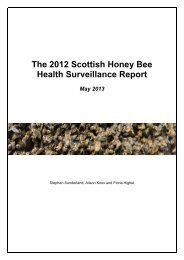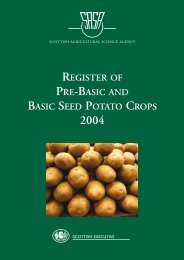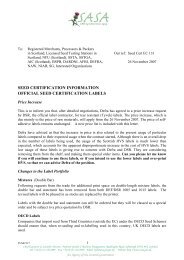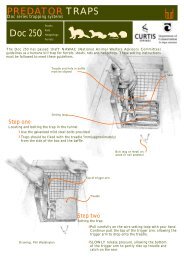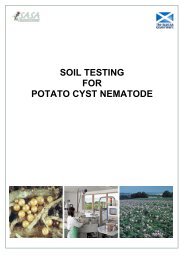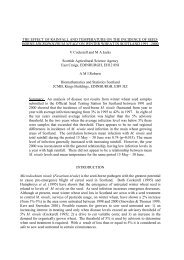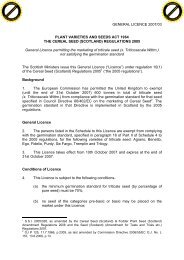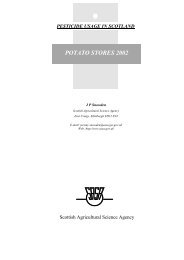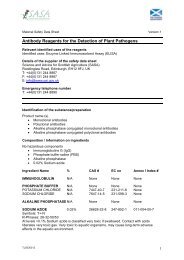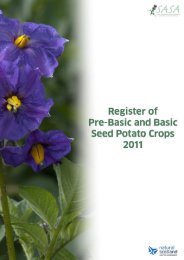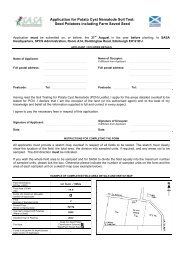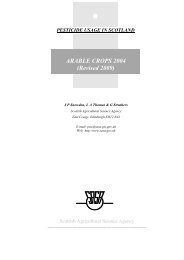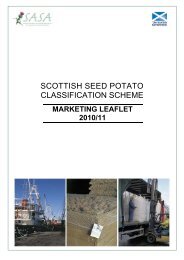Pesticide Poisoning Report 2011 - SASA
Pesticide Poisoning Report 2011 - SASA
Pesticide Poisoning Report 2011 - SASA
Create successful ePaper yourself
Turn your PDF publications into a flip-book with our unique Google optimized e-Paper software.
<strong>Pesticide</strong> <strong>Poisoning</strong> ofAnimals in <strong>2011</strong>A <strong>Report</strong> of Investigations in Scotland
PESTICIDE POISONINGOF ANIMALS IN <strong>2011</strong>INVESTIGATIONS OFSUSPECTED INCIDENTS IN SCOTLANDE A Sharp, L M Melton,M J Taylor, and J E Watson<strong>Pesticide</strong>s & Wildlife Branch<strong>SASA</strong>, Roddinglaw Road, Edinburgh, EH12 9FJA Division of the Scottish Government Agriculture, Food and Rural Communities Directorate
PESTICIDE POISONINGOF ANIMALS IN <strong>2011</strong>INVESTIGATIONS OFSUSPECTED INCIDENTS IN SCOTLANDE A Sharp, L M Melton,M J Taylor, and J E Watson<strong>Pesticide</strong>s & Wildlife Branch<strong>SASA</strong>, Roddinglaw Road, Edinburgh, EH12 9FJA Division of the Scottish Government Agriculture, Food and Rural Communities Directorate
CONTENTSSUMMARY ........................................................................................................ 1PageINTRODUCTION ............................................................................................... 2INCIDENTS IN <strong>2011</strong> ......................................................................................... 4Number of incidents in <strong>2011</strong> ...................................................................... 4CATEGORISED INCIDENTS ............................................................................ 8Approved use ............................................................................................ 8Misuse ...................................................................................................... 8Abuse ........................................................................................................ 9Unspecified Use ........................................................................................ 10ANTICOAGULANT RODENTICIDES ............................................................... 11APPENDICESAppendix I Investigation procedures .................................................... 13Appendix II Summary of Positive Incidents <strong>2011</strong> .................................. 15Appendix III Regions in Scotland used to classify incidents ................... 28TLP010812
SUMMARYThe Wildlife Incident Investigation Scheme (WIIS) operated in Scotland by Science andAdvice for Scottish Agriculture (<strong>SASA</strong>) <strong>Pesticide</strong>s & Wildlife Branchhttp://www.sasa.gov.uk/wildlife-environment/wildlife-incident-investigation-scheme-wiisinvestigates suspected poisoning of wildlife, beneficial insects, companion animals andlivestock if there is evidence to indicate that pesticides or biocides 1 may be involved.The scheme, together with similar schemes operating in England & Wales and NorthernIreland, provides a means of post-registration surveillance of pesticide use throughoutthe UK, so that registration may be revised if necessary. These schemes also providea measure of the success of the pesticide registration process and help in theverification and improvement of the risk assessments made in the registration ofcompounds. Incidents of approved use and of misuse can highlight problems with theapproval conditions or the label instructions for a pesticide, and can provide valuablefeedback into the regulatory process.The scheme in Scotland also provides evidence that can be used by the ScottishGovernment or the police, to enforce legislation relating to the safe use of pesticidesand the protection of food, the environment and animals.In <strong>2011</strong>, there were 237 incidents (which included 5 bee incidents) submitted to theWIIS Scotland. This represented a slight increase compared to the 233 received in2010. Four incidents were excluded 2 , leaving 233 incidents accepted for furtherinvestigation. The cause of death or illness was determined in 129 incidents. Ninetyfour incidents (40% of all incidents accepted into the WIIS Scotland) tested positive forpesticides and other chemicals 3 . Twenty-five of these incidents were attributed topesticide poisoning.Sixteen incidents were categorised as abuse, 5 incidents were attributed to unspecifieduse, one incident followed approved use and 3 incidents were categorised as misuse.Eighteen different pesticides or chemicals were identified (see Table 2). Theinsecticide, carbofuran was detected in 9 out of 16 (56%) incidents categorised asabuse, even though UK approval for use of products containing this chemical expired in2001.Selected samples were also screened for evidence of exposure to anticoagulantrodenticides. Residues of various anticoagulant rodenticides were detected in 87 out of210 incidents (i.e. 41% of those incidents selected for rodenticide screening). Thesecond generation anticoagulant rodenticides, bromadiolone, brodifacoum anddifenacoum were found to be the most prevalent active ingredients detected.1 In recent years, some non-agricultural pesticides have been classified as biocides e.g. anticoagulant rodenticides.However, throughout this report ‘pesticide’ or ‘pesticides’ will be used as the generic terminology.23Excluded refers to incidents where the criteria for acceptance into the WIIS Scotland have not been met or wherethere is no suitable material for analysis.Includes incidents that involved veterinary medicines and ethylene glycol.1
INTRODUCTION1. In the United Kingdom the impact of pesticide use on non-target vertebratewildlife and other animals including honey bees, companion animals andlivestock, is assessed before approval is granted by the regulatory body. Inorder to protect animals, restrictions on use may be imposed in the conditions ofapproval made under the Control of <strong>Pesticide</strong>s Regulations (COPR) 1986 (asamended) or the Plant Protection Products Regulations (<strong>2011</strong>), where it isthought that an unacceptable risk would arise.2. The WIIS Scotland is one of four schemes, operating in the United Kingdom,which investigates possible pesticide poisoning of animals. The WIIS Scotlandis operated by <strong>SASA</strong>’s <strong>Pesticide</strong>s & Wildlife Branch on behalf of the ScottishGovernment Agriculture, Food and Rural Communities Directorate (AFRC). Theprocedures for incident investigation are described in Appendix I.3. Incidents confirmed as involving pesticides that were considered to beresponsible for the cause of death or illness of an animal or that contravenerelated legislation are assigned to one of the following categories:Approved use of the product, according to the specified conditions ofuse;Misuse of a product, by careless, accidental or wilful failure to adhere tothe correct practice;Abuse of a pesticide, in the form of deliberate, illegal attempts to poisonanimals;Unspecified use, where the cause could not be assigned to one of theabove categories. Veterinary use, where subsequent investigation identifies theinvolvement of a pesticide formulated as a veterinary medicine. Suchcases are investigated incidentally rather than deliberately, and mayinclude abuse, misuse, approved use, or unspecified use of the relevantcompounds.4. The results of investigations are ultimately reported to the Environmental Panelof the UK Advisory Committee on <strong>Pesticide</strong>s (ACP)http://www.pesticides.gov.uk/guidance/industries/pesticides/advisorygroups/acp. Theinformation provided may result in a re-evaluation of the approvals previouslygranted to products, or may affect the progress to full commercial use ofproducts currently under provisional approval. Information from incidents assistsin the validation and improvement of the risk assessment procedures used bythe regulatory body for new and existing compounds.5. The majority of this post-registration surveillance activity is funded by theagricultural and non-agricultural sectors of the pesticide industry, under the Food2
and Environment Protection Act 1985 (FEPA) and Control of <strong>Pesticide</strong>sRegulations (COPR). In cases where there is evidence to indicate misuse ordeliberate abuse of a pesticide, the results of investigations may also lead tolegal enforcement. Under FEPA and COPR, all aspects of pesticideadvertisement, sale, supply, storage and use are fully regulated. If investigationsreveal contravention of FEPA, COPR, or other legislation such as the Wildlifeand Countryside Act 1981 or Possession of <strong>Pesticide</strong>s (Scotland) Order 2005,then prosecution or other forms of enforcement may ensue. All activities carriedout to enforce the legislation in Scotland are funded by the Scottish Government.6. The WIIS Hotline number (freephone: 0800 321600) is routed to <strong>SASA</strong> andprovides access for incident notification. To prevent large numbers of deadanimals being submitted and analysed, strict criteria are applied to potentialincidents prior to acceptance.Incidents are usually excluded from analysis when there is insufficient orunsuitable sample. However, details are recorded for reference purposes.3
INCIDENTS IN <strong>2011</strong>NUMBER OF INCIDENTS IN <strong>2011</strong>7. A total of 237 suspected poisoning incidents were referred to the WIIS Scotlandthroughout <strong>2011</strong> (Figure 1). Four incidents were excluded leaving 233 incidentsaccepted for subsequent investigation.<strong>Pesticide</strong>s and other chemicals were detected in 94 separate incidents i.e. 40%of all incidents investigated (Appendix II).260Number of incidentsreferred annually to the WIIS-Scotland2402202332372001901801601401201441671351671271581521211571771751661001997 1998 1999 2000 2001 2002 2003 2004 2005 2006 2007 2008 2009 2010 <strong>2011</strong>YearFigure 1. Number of incidents referred to the WIIS (Scotland) per annum (1997-<strong>2011</strong>).8. The cause of death or illness was established in 129 incidents. 25 of theseincidents involved pesticides and were assigned to an appropriate WIIScategory. In the remaining 104 incidents, death of the animal was concluded tobe due to starvation (28), disease (7), trauma (68) and ethylene glycol (1).9. One incident was attributed to the approved use of pesticides. The details of theincident were forwarded to <strong>SASA</strong> by Chemicals Regulation Directorate (CRD)(http://www.hse.gov.uk/index.htm) after a veterinary surgeon reported treating adog that had became ill after ingesting “Bio Slug Mini Pellets” containingmetaldehyde. Three incidents were categorised as misuse. Two involved dogsand the other involved cattle. In a further 5 incidents, it was not possible toidentify a specific source of the pesticide residues detected and the cause ofeach incident was categorised as unspecified use. Sixteen incidents werecategorised as abuse. Further details of these poisoning incidents are providedin the Categorised Incidents section. A breakdown of all 233 incidents ispresented in Tables 1-3.4
Table 1: Number of incidents investigated in <strong>2011</strong>abcSampleclassification aIncidentsInvestigatedIncidentsinvolvingpesticides bCategorisedincidents cIncidentswith otherknown causeof death orillnessVertebrate wildlife 177 84 17 100Livestock 1 1 1 0Companion animals 35 6 5 2Honey bees 5 0 0 2Bait, chemical orparaphernalia15 3 2 Not applicableTOTAL 233 94 25 104Where single incidents involved submission of several sample types – the sample was simply classifiedby the first named specimen.All incidents including those involving veterinary medicines and ethylene glycol.Incidents involving ethylene glycol and veterinary drugs only were not assigned to a WIIS category.A list of the pesticides and other chemicals detected during <strong>2011</strong> is presented in Table2.Table 2: Identity and frequency of pesticides detected in incidents andassociated sample typesChemicalNumberof Sample type apositiveincidentsaldicarb 3 bait, buzzard, cataldicarb sulfoxide b 3 bait, buzzard, catbendiocarb 2 raven, red kitebrodifacoum 26 buzzard, dog, fox, red kite, sea eagle,sparrowhawk, tawny owlbromadiolone 61 bait, barn owl, buzzard, dog, fox, golden eagle,kestrel, otter, peregrine falcon, rabbit, red kite,sparrowhawk, tawny owlcarbofuran 9 buzzard, chemical, golden eagle, raven, red kite,sparrowhawkchloralose 2 bait, buzzard, crow, paraphernalia, red kitecoumatetralyl 4 fox, peregrine falcon, tawny owldiazinon 1 chemicaldifenacoum 34 buzzard, fox, red kite, sea eagle, sparrowhawkdimetridazole 1 chemicalethylene glycol 1 catmetaldehyde 1 cattle5
abChemicalNumberof Sample type apositiveincidentsmethiocarb 1 dognovocaine 1 chemicaloxytetracycline 1 chemicalpenicillin G 1 chemicalstrychnine 1 bait, peregrine falconAn individual incident may have involved submission of multiple sample types and/or detection of morethan one pesticide.Aldicarb sulfoxide is a metabolite of aldicarbTable 3 contains details of the variety and number of specimens tested by <strong>SASA</strong><strong>Pesticide</strong>s & Wildlife Branch and the number where pesticide residues were detected.The presence of a pesticide residue does not imply pesticide poisoning was the causeof death.Table 3: Species and number tested (including detected residues) in <strong>2011</strong>Species or sample type6Number tested(residue detected)Mammals - wildlifeBadger 2 (0)Fox 46 (36)Mole 1 (0)Otter 1 (1)Rabbit 1 (0)Rat 1 (0)Squirrel - red 2 (0)BirdsBuzzard 60 (26)Eagle - golden 7 (1)Eagle - sea 7 (3)Goshawk 2 (0)Kestrel 4 (1)Merlin 1 (0)Owl - barn 2 (1)Owl – long-eared 1 (0)Owl – short-eared 1 (0)Owl - tawny 9 (4)Peregrine falcon 4 (3)Red kite 17 (11)Sparrowhawk 15 (8)
Species or sample typeNumber tested(residue detected)Chaffinch 1 (0)Greenfinch 3 (0)Pigeon 2 (0)Sparrow 1 (0)Gannet 1 (0)Gull 3 (0)Oystercatcher 1 (0)Swan 5 (0)Capercaillie 1 (0)Red-legged partridge 2 (0)Crow 6 (2)Jackdaw 1 (0)Raven 4 (2)Rook 5 (0)Companion AnimalsCat 15 (3)Dog 14 (4)Guineapig 1 (0)LivestockCattle 1 (1)Beneficial InsectsHoney bees 5 (0)MiscellaneousDeer (suspected bait) 2 (0)Eggs (suspected bait) 3 (0)Dog food (suspected bait) 1 (0)Grouse (suspected bait) 3 (1)Hare (suspected bait) 3 (0)Animal remains (suspected bait) 9 (0)Paraphernalia (e.g. knives, game bags, gloves) 21 (0)Pheasant (suspected bait) 4 (2)Pigeon (suspected bait) 3 (1)Rabbit (suspected bait) 9 (0)Sausage/meat (suspected bait) 2 (0)Suspicious chemicals and substances e.g. soil, debris 49 (26)Total number of specimens tested 365 (137)7
CATEGORISED INCIDENTSAPPROVED USE10. A veterinary surgeon reported the details of this incident, which occurred inLothian, to the CRD. A dog was treated for severe toxicity after ingesting a slugpellet formulation containing metaldehyde that had been applied to address aslug problem in the owner’s garden. The owner was unaware of the potentialtoxicity to dogs, believing the product to be ‘safe’ from the labelling on thepackaging. The wording on the labelling for metaldehyde and methiocarb slugpellet products has been reviewed over the last few years due to the largenumber of incidents reported to the National Poisons Information Service (NPIS)that involve garden pesticides and children. The phrase “since this productcontains metaldehyde, which can kill if eaten, it must be kept away from childrenand pets” is now required on all slug pellet products containing these activeingredients. Some products also carried a phrase “this product contains ananimal repellent to reduce attractiveness of pellets to domestic animals” andCRD now require this to be removed to avoid the possibility of undermining thegeneral warning to keep the pellets away from pets. Other changes, such asnew packaging design to restrict the flow of pellets from the container and aclear ‘scatter diagram’ or picture to illustrate the correct method of applicationhave also been introduced to improve the safety of such products. However, itappears that the approval for the product that was used may have expired andconsequently the packaging may not have borne the amended warning phrasesor safety features that might have avoided this incident.MISUSE11. Three incidents in <strong>2011</strong> were attributed to misuse. The first, which occurred inFebruary, resulted in the death of a working gun dog following massive pleuraland abdominal haemorrhage. The analytical investigation identified a significantresidue of brodifacoum in liver tissue from the dog confirming anticoagulantrodenticide poisoning was likely to be responsible for the dog’s death. Aninvestigation into the circumstances surrounding the incident confirmed that‘Jaguar’, an anticoagulant rodenticide formulation containing brodifacoum, hadbeen used to control a rat infestation in a recently emptied chicken house.Brodifacoum-based anticoagulant rodenticide products are only approved for usein indoor situations and the inspector was satisfied that the bait had been usedappropriately. The chicken unit was situated behind two fences and the ownerinsisted that the gates and unit had been kept securely fastened whilst therodenticide blocks were in use. The dog was allowed free unattended access tothe area of the holding but never allowed into the area of the chicken house.However, although all the appropriate precautions appear to have been takenthe dog died following accidental exposure to brodifacoum.In June, a cocker spaniel became ill after being walked in a rural area ofPerthshire. It was taken for veterinary treatment and the veterinary surgeonnoticed a blue colouration was apparent in the vomit and faeces. It wassuspected that the dog had ingested slug pellets and that metaldehyde poisoning8
was the likely cause of the illness. The laboratory analysis revealed a residue ofmethiocarb, another active ingredient used in slug pellets, in a sample of faecesfrom the animal. A field investigation undertaken by Scottish GovernmentAgricultural staff concluded that the dog had ingested the poison whilst rootingaround in rubbish.In the third misuse incident cattle died after ingesting a quantity of metaldehydeslug pellets. The affected cattle were part of a group of 18 animals that hadbeen in a rented field since the end of April <strong>2011</strong>. The first indication that aproblem existed occurred in mid-August when two animals were found collapsedand trembling in respiratory distress and a third was unwell and twitching. Thefindings of the post mortem examination, carried out by SAC Veterinary Servicesin Penicuik, suggested that the animals had ingested a slug pellet formulationwhen small, blue pellets were found in the animal’s intestines. The laboratoryinvestigation confirmed that suspicion by identifying a residue of metaldehyde ina sample of rumen contents. The field investigation established that the fieldwhere the cattle were grazing, which is permanent pasture, has a disused quarrywithin it which is sometimes used by the landlord for burning waste paper. It wasalso established that the landlord has a large vegetable processing business andthat metaldehyde slug pellets are used on these crops but were not used on thepermanent grassland. A search of the field and disused quarry failed to uncoverany evidence of metaldehyde and the source of the chemical remains uncertain.However, it may be that a container with some metaldehyde inadvertently endedup amongst rubbish waiting to be burnt and that allowed the stock to gain accessto the poison.ABUSE12. In <strong>2011</strong>, sixteen incidents were categorised as abuse compared to 32 incidentsin this category in 2010. Analytical investigations included analysis of tissuesamples, digestive tract material, various chemicals and poisoning paraphernalia(e.g. implements/tools, game bags and sweepings from vehicles). As inprevious years, a high proportion (63%) of abuse incidents involved birds of prey(Figure 2).<strong>2011</strong>20092007200520032001199919970 5 10 15 20 25 30 35 40Birds of Prey Companion Animals OthersFigure 2. Abuse of pesticides in Scotland (number of incidents 1997 - <strong>2011</strong>).9
13. Ten abuse incidents involved birds of prey (Table 4). The 6 others included; cat(1), crow (1), dog (1), raven (1) and suspected baits (2).Table 4: Number of birds of prey that were victims of pesticide abuse in <strong>2011</strong>Region aNumberofincidentsBuzzardRedKitePeregrineFalconSparrowhawk GoldenEagleBorder 1 1 - - - -Dumfries &Galloway1 - 1 - - -Grampian 1 1 - - - 1Highland 3 1 2 - - -Lothian 1 2 - - 2 -Strathclyde 2 - 1 2 - -Tayside 1 2 - - - -TOTAL 10 7 4 2 2 1a See appendix III for regional classification in Scotland14. Seven different pesticides and/or their metabolites were detected and identifiedin abuse incidents in <strong>2011</strong>. The pesticides were aldicarb, aldicarb sulfoxide,bendiocarb, bromadiolone, carbofuran, chloralose, and strychnine.UNSPECIFIED USE15. Sometimes it is not possible to definitely establish the source of a pesticidewhich has been positively detected and is present at levels considered to pose asignificant risk of mortality. Such cases are categorised as ‘Unspecified Use’. In<strong>2011</strong> 5 incidents, all involving anticoagulant rodenticides fell into this category.Animals and pesticides involved in these incidents are listed in Table 5.Table 5: Unspecified Use incidents recorded in <strong>2011</strong>Region <strong>Pesticide</strong>s Month SpeciesBorderDumfries &Gallowaybrodifacoum, bromadiolone,difenacoumbrodifacoum, bromadiolone,difenacoumFebruaryAprilbuzzard, tawnyowlred kiteLothian bromadiolone, difenacoum February foxLothian difenacoum March buzzardStrathclyde brodifacoum, bromadiolone March fox10
ANTICOAGULANT RODENTICIDES16. Non-target animals are occasionally casualties of poisoning caused by wilful oraccidental non-compliance with good practice in rodenticide baiting. Indirect orsecondary poisoning can also occur when predators, scavengers or curiousanimals ingest rodents killed or affected by rodenticides. The WIIS Scotlandoffers a unique opportunity to probe wider environmental contamination bylooking for rodenticide residues present in non-target animals that otherwisewould not be available. Routine monitoring of liver tissue from wild mammals,birds of prey and other animals is carried out in order to assess the magnitudeand frequency of exposure to anticoagulant rodenticides. The results provide aneffective indication of the non-target animals exposed to anticoagulantrodenticides.In <strong>2011</strong>, <strong>SASA</strong> <strong>Pesticide</strong>s & Wildlife Branch tested 210 livers from a variety ofanimals for the presence of residues of anticoagulant rodenticides. Residueswere detected and identified in the livers of 87 specimens i.e. 41% of the totalnumber of livers tested (Table 6).Table 6: Species tested throughout <strong>2011</strong> for the presence of residues ofanticoagulant rodenticides aSpecies Number tested Number positive bBuzzard 50 21Eagle-golden 5 1Eagle-sea 5 3Goshawk 2 -Kestrel 4 1Merlin 1 -Peregrine falcon 4 2Red kite 14 9Sparrowhawk 15 7Barn Owl 2 1Long-eared Owl 1 -Short-eared Owl 1 -Tawny owl 9 4Crow 3 -Jackdaw 1 -Raven 4 -Rook 5 -Greenfinch 3 -Pigeon 1 -Chaffinch 1 -Capercaillie 1 -11
Species Number tested Number positive bGull 4 -Partridge 2 -Swan 5 -Badger 2 -Cat 3 -Dog 10 1Fox 46 36Mole 1 -Otter 1 1Rabbit 1 -Rat 1 -Red Squirrel 2 -TOTAL 210 87abBrodifacoum, bromadiolone, chlorophacinone, coumatetralyl, difenacoum, difethialone, diphacinone,flocoumafen & warfarin.This is the total number of specimens that tested positive from 210 livers examined. An individual WIISincident may involve >1 specimen.*12
APPENDIX IINVESTIGATION PROCEDURESThe investigation of suspected pesticide poisoning incidents relies on a scheme, whichallows members of the public and interested organisations to notify relevant agenciesand facilitate submission of carcases, suspected baits or other samples for pesticideanalysis. The Wildlife Incident Investigation Scheme is operated in Scotland by the<strong>Pesticide</strong>s and Wildlife Branch at <strong>SASA</strong> on behalf of the Scottish Government.Agricultural Staff in area offices located throughout Scotland, provide support whennecessary for field investigations, and also act as an additional point of contact fornotification of incidents.A number of environmental and animal welfare organisations, such as the RSPB-Scotland and the Scottish Society for the Prevention of Cruelty to Animals, play anactive role in some incident investigations. These bodies act not only by assistingmembers of the public to notify incidents, but also by screening out inappropriate casesprior to notification.The Scottish Agricultural College (SAC) Veterinary Service acts in partnership with thescheme, in forwarding relevant samples to <strong>SASA</strong> from potential incidents notifiedindirectly via its laboratories, and by screening out incidents that are unlikely to involvepesticides. The post mortem examinations undertaken by these laboratories mayidentify disease, trauma, starvation or other causes of death, eliminating the need forexpensive analytical investigation.As well as investigating incidents involving wildlife, the scheme covers suspectedpoisoning of livestock, companion animals and beneficial insects and investigatessuspicious substances and suspected baits. Incidents may be rejected if they fall outwith the remit of the scheme, or if other acceptance criteria are not met.<strong>SASA</strong> makes use of various analytical techniques, methods and instrumentation todetect, identify and quantify pesticide residues. Two multi-residue methods arecurrently used to determine and quantify:(1) <strong>Pesticide</strong>s(2) Anticoagulant rodenticides.These multi-residue methods are supplemented by compound-specific analyticalmethods developed for the determination of chloralose, metaldehyde, paraquat,strychnine and gassing compounds. Wherever possible, residues are confirmed usingan alternative analytical technique or measurement parameter.Field investigations are normally only triggered following the positive detection andidentification of pesticide(s) in or on the test specimen. However, field investigationsmay also be initiated if sufficient evidence of pesticide involvement is available e.g.following direct notification or after post-mortem examination.Analytical results, post-mortem findings and field investigation reports are collated andinterpreted by <strong>Pesticide</strong>s and Wildlife Branch specialists in order to categorise anincident and to determine whether residue levels detected contributed to the death orillness of the animal involved. In some cases, the presence of residues in associationwith typical post-mortem findings may be used to determine mortality.13
The results of investigations in Scotland are presented annually in this report series andin reports published by the UK regulatory body, The Chemicals Regulation Directorate,who are able to assess relevant incident information for any implications for theapproval status of a particular pesticide or family of pesticides. Where legalproceedings are used as part of enforcement action, the evidence gathered by <strong>SASA</strong><strong>Pesticide</strong>s & Wildlife Branch and SG Agricultural Staff, is presented in reports to theProcurator Fiscal Service. Police forces are active partners in countering pesticideabuse and take the lead in investigations and presentation of such cases to theProcurator Fiscal.How to <strong>Report</strong> Incidents<strong>SASA</strong> Websitehttp://www.sasa.gov.uk/wildlife-environment/wildlife-incident-investigation-scheme-wiisPAW Scotlandhttp://www.scotland.gov.uk/Topics/Environment/Wildlife-Habitats/paw-scotland/what-you-can-do14
SUMMARY OF INCIDENTS THAT TESTED POSITIVE FOR PESTICIDE RESIDUES – <strong>2011</strong> 1APPENDIX IIRef. Month Region Chemical Category Species Comments11001 January Dumfries &Gallowaybromadiolonebrodifacoumtrauma red kite This bird was found dead at the roadside with a deadpheasant lying nearby. There was concern that the kite mighthave been poisoned. However, the laboratory investigationonly confirmed exposure to anticoagulant rodenticides.11002 January Border brodifacoum starvation buzzard Buzzard found dead by a walker. The concern that it mayhave been poisoned was not substantiated. A low residue ofbrodifacoum was confirmed in liver tissue from the bird.11003 January Central bromadiolone starvation buzzard This buzzard was found dead in a tree by a member of thepublic. The analytical investigation failed to provide anyevidence to implicate pesticide poisoning but confirmed a lowresidue of bromadiolone in liver tissue.11006 January Border carbofuran(bromadiolone)11007 January Fife bromadiolonebrodifacoumdifenacoumabuse buzzard The buzzard was found dead in an area where there is aunknown white tailedeaglehistory of bird of prey persecution. Although the carcase wasin an advanced state of autolysis residues of carbofuran wereconfirmed in liver tissue and the gizzard contents from thebird. However, no enforcement action has been taken due toa lack of evidence. A very low residue of bromadiolone wasalso detected in liver tissue from the bird.This bird was found dead behind a stock fence near to anarea of forestry. The analytical investigation failed to provideany evidence to implicate pesticide poisoning but confirmedthe presence of low residues of bromadiolone, brodifacoumand difenacoum in liver tissue.11010 January Strathclyde brodifacoum misuse dog This dog died following massive pleural and abdominalhaemorrhage. The analytical investigation confirmed aresidue of brodifacoum in liver tissue from the dog. A fieldinvestigation, undertaken by AFRC agricultural staff,established that 'Jaguar' rodenticide blocks containingbrodifacoum were in use in a chicken house on the premises.Although all the appropriate precautions had been taken thisdog appears to have died following accidental exposure to therodenticide product.15
Ref. Month Region Chemical Category Species Comments11012 February Dumfries &Gallowaybromadiolonedifenacoum11017 January Lothian bromadiolonedifenacoumtrauma red kite This bird was found tangled in barbed wire on a pylon; lowresidues of anticoagulant rodenticide residues were detectedin liver tissue.unknown fox Fox found dead by a member of the public who wasconcerned that it may have been poisoned. The analyticalinvestigation failed to provide any evidence of pesticidepoisoning but revealed low residues of two anticoagulantrodenticides in the liver tissue.11020 February Highland chloralose abuse red kite The police were concerned that this bird may have beenpoisoned. The analytical investigation revealed a grossresidue of chloralose in the crop material from the bird.Unfortunately no enforcement action has been pursued due toinsufficient evidence.11022 January Strathclyde difenacoum trauma sparrowhawk This sparrowhawk was found dead with a fractured right11024 February Strathclyde strychnine(bromadiolone)11025 February Grampian brodifacoumdifenacoum11026 February Border bromadiolonebrodifacoumdifenacoumabuse 2 peregrinefalcons and asuspectedpigeon baitclavicle. A very low residue of difenacoum was detected inthe liver tissue submitted for anticoagulant rodenticideanalysis.These carcases were submitted by Scottish SPCA inspectors.Residues of strychnine were detected in tissues from bothperegrines and on the pigeon remains. This case has beenclosed due to a lack of evidence. A very low residue ofbromadiolone was also confirmed in liver tissue from one ofthe peregrines.starvation buzzard This buzzard was found on top of a granite pillar at theentrance to a private house. The post mortem examinationfindings indicated that starvation was the likely cause ofdeath. The opportunity was taken to test liver tissue from thebird for evidence of exposure to anticoagulant rodenticides.The analysis confirmed the presence of very low residues ofbrodifacoum and difenacoum.unspecified tawny owl andbuzzardThese birds were found dead at the same location within thespace of one week. The post mortem examination findingsraised the possibility of anticoagulant rodenticide poisoningbeing responsible for their deaths. The analysis confirmedthat suspicion by revealing residues of rodenticides at levelsthat were considered to be within the anticipated lethal range.16
Ref. Month Region Chemical Category Species Comments11030 February Lothian bromadiolone unknown fox This fox was found dead in an area where several other deadfoxes had been reported. An extensive analyticalinvestigation only revealed a low residue of bromadiolone inliver tissue from the animal.11032 February Lothian bromadiolone unspecified fox This fox was found dead on the finder's lawn. The laboratorydifenacoumanalysis identified residues of bromadiolone and difenacoumin liver tissue. The residues were at levels that wouldnormally be considered to be within the anticipated lethalrange. The source of the chemicals has not beenestablished.11040 March Lothian difenacoum unspecified buzzard The residue of difenacoum detected in the liver tissue from11041 March Tayside chloralose(bromadiolone)11045 March Strathclyde bromadiolonebrodifacoum11046 March Grampian carbofuran(bromadiolone)11048 March Border bromadiolonedifenacoumabuse 2 buzzards,two suspectedpheasant baitsand 2 crowsthis bird indicated that anticoagulant rodenticide poisoningprobably contributed to the death. The source of the chemicalis still uncertain.This incident is the subject of an ongoing police investigation.A low residue of bromadiolone was detected in liver tissuefrom one of the buzzards.unspecified fox This is one of several animals found dead in the same area.The laboratory tests have confirmed residues of bromadioloneand brodifacoum in liver tissue. The bromadiolone residuelevel was within the anticipated lethal range. However, thesource of the chemical has not been established.abuse golden eagleand a buzzardThis satellite tagged eagle was found to have been poisonedwith carbofuran. A buzzard carcase seized during the fieldsearch was also confirmed to have been poisoned. However,there was insufficient evidence to pursue any enforcementaction and this case is now closed. A low residue ofbromadiolone was also detected in the liver tissue from theeagle.unknown buzzard Two buzzards found dead below power lines. The analyticalinvestigation confirmed the presence of low residues ofbromadiolone and difenacoum in liver tissue from one of thebirds.17
Ref. Month Region Chemical Category Species Comments11052 March Tayside bromadiolone brodifacoumdifenacoumstarvation buzzard Found dead in poor bodily condition. The laboratory11054 April Highland aldicarbcarbofuran11056 April Lothian bromadiolonedifenacoum11057 April Dumfries &Gallowaybromadiolonedifenacoumbrodifacouminvestigation was restricted to screening for evidence ofexposure to anticoagulant rodenticides. Low residues ofbromadiolone, brodifacoum and difenacoum were confirmedin liver tissue.abuse buzzard The laboratory investigation confirmed the presence ofresidues of the carbamate insecticides, aldicarb andcarbofuran, in tissue samples analysed from this bird.However, no further police investigation has been undertakendue to a lack of evidence.unknown buzzard Three buzzards were found dead together on the groundunder an electricity pylon. The post mortem examinationfailed to establish the cause of death. The laboratoryinvestigation confirmed the presence of low residues of theanticoagulant rodenticides bromadiolone and difenacoum inliver tissue from one of the birds.unspecified red kite Low residues of three anticoagulant rodenticides wereconfirmed in liver tissue from this bird. The combined residuelevel indicates that anticoagulant rodenticide poisoningprobably contributed to the death. The source of thechemicals has not been established.11062 April Strathclyde difenacoum starvation sparrowhawk Found dead in a garden. The post mortem examinationfindings suggested that starvation was the likely cause ofdeath in this instance. A low residue of difenacoum wasconfirmed in liver tissue from the bird.11064 April Grampian bromadiolonecoumatetralylstarvation tawny owl The post mortem examination identified starvation as thelikely cause of this owl's death. Low residues of twoanticoagulant rodenticides were found in liver tissue from thebird.11066 April Highland difenacoum disease buzzard Septicaemia was identified as the cause of this buzzard's11069 April Highland difenacoumbrodifacoumdemise. A low residue of difenacoum was detected in livertissue.starvation sparrowhawk This bird was found dead in a garden and starvation wasthought to be the possible cause of death. Very low residuesof brodifacoum and difenacoum were confirmed in liver tissue.18
Ref. Month Region Chemical Category Species Comments11075 May Lothian aldicarbaldicarbsulfoxide11079 May Dumfries &Galloway11083 May Highland bendiocarbcarbofuranabuse 2 cats Three cats from the same area were found dead and a fourthcat was euthanased. Tissues from 3 of the cats weresubmitted for analysis. Residues of aldicarb and itsmetabolite aldicarb sulfoxide were identified in tissues from 2of the animals. The source of the aldicarb has not beenestablished.carbofuran abuse raven The analytical investigation confirmed that this raven had diedfrom carbofuran poisoning. No further action has beenpossible due to insufficient evidence.abuse red kite Following a report of a dead red kite the police carried out aground search and collected the red kite and skeletal remainsof another bird. The analytical investigation detected residuesof bendiocarb and carbofuran in the samples from the red kiteonly. The case is now closed due to a lack of evidence.11087 May Strathclyde bromadiolone trauma fox A dead fox was found in a field in a country park. Foxes hadbeen being fed by a member of the public and it was notedthat 8 had stopped coming for food. The post mortemexamination revealed that it had multiple skull fracturesresulting from blunt trauma. A significant residue ofbromadiolone was confirmed in liver tissue but a fieldinvestigation has failed to establish the source of thechemical.11091 May Tayside methiocarb misuse dog Dog became ill after rummaging in rubbish whilst beingwalked. It later recovered after receiving veterinary treatment.The analytical investigation confirmed that the dog hadingested a quantity of methiocarb slug pellets. The source ofthe methiocarb has not been established.11093 June Dumfries &Gallowaybromadiolonedifenacoumstarvation red kite Low residues of two anticoagulant rodenticides were detectedin liver from this red kite. The post mortem examinationfindings indicated that starvation was the likely cause ofdeath.11094 May Highland brodifacoum trauma buzzard The residue of brodifacoum detected in this buzzard wasapproaching the level where adverse effects would beexpected. However, in this case there was circumstantial andpost mortem evidence to indicate that electrocution was thelikely cause of death.19
Ref. Month Region Chemical Category Species Comments11097 June Strathclyde ethylene glycol other cat There was concern that this cat had died as a result ofpesticide poisoning. The analytical investigation failed toconfirm that suspicion but kidney histopathology indicated thatethylene glycol poisoning was the cause of death.11101 June Dumfries &Gallowaybromadiolone unknown otter This otter was found dead on a river bank. It was the secondotter to have died in the area within a two week period. Thepost mortem examination and analytical investigation failed toestablish the cause of death. A low, sub-lethal residue ofbromadiolone was detected in liver tissue.11103 May Lothian metaldehyde approved dog Dog became ill after ingesting metaldehyde slug pelletsapplied to the garden by its owner. The dog recoveredfollowing veterinary treatment.11105 June Highland difenacoum trauma buzzard The post mortem examination findings indicated that traumaassociated with a blow to the head was the likely cause ofdeath in this incident. A very low residue of difenacoum wasconfirmed in liver tissue.11109 June WesternIslesdifenacoum unknown white tailedeagleThis bird was found dead on a croft. The cause of death hasnot been established. A low residue of difenacoum wasconfirmed in liver tissue.11113 July Lothian difenacoum trauma buzzard This bird was found dead at the side of the A68. There areconcerns that the local population of buzzards andsparrowhawks has declined recently. The analyticalinvestigation confirmed the presence of a very low residue ofdifenacoum in liver tissue.11115 July Dumfries &Gallowaycarbofuran(bromadiolone)abuse red kite A gamekeeper reported finding a dead red kite to the police.Residues of carbofuran were confirmed in both the liver tissueand the stomach contents from the bird confirming carbofuranpoisoning as the cause of the bird’s demise. However, due toinsufficient evidence no enforcement action has been taken.A low residue of bromadiolone was also confirmed in livertissue.20
Ref. Month Region Chemical Category Species Comments11123 July Lothian novocaine penicillin Gother chemical A small bottle containing orange liquid and a cream colouredsediment was found on a tree stump. The analyticalinvestigation confirmed that the bottle contained a mixture ofnovocaine (a chemical used as an anaesthetic) and penicillinG (an antibiotic). Police enquiries have failed to establish thesource of this veterinary medicine.11126 July Grampian difenacoum unknown red kite Young bird found alive but unable to fly. The bird died despitereceiving veterinary treatment. A low residue of difenacoumwas confirmed in liver tissue from the bird11128 August Lothian bromadiolone trauma sparrowhawk Found dead under bushes in a garden. The post mortemexamination findings indicated trauma was the likely cause ofdeath. A low residue of bromadiolone was confirmed in livertissue.11129 August Dumfries &Gallowaybromadiolonedifenacoumstarvation red kite This bird was found alive but was subsequently euthanased.It was very thin with no fat reserves. Low residues ofbromadiolone and difenacoum were found in liver tissue.11133 August Lothian metaldehyde misuse cattle Three animals, out of a group of 18 young cattle in a field,were found unwell. Two died. The post mortem examinationof one of the animals revealed the presence of small bluepellets in the intestines. The analytical investigationconfirmed a residue of metaldehyde in the sample. It isthought that improper disposal of the product packaging mightbe responsible for this incident.11136 August Grampian coumatetralyl trauma peregrinefalconThis bird had been shot. The opportunity was taken to screenfor evidence of exposure to anticoagulant rodenticides. Thisconfirmed the presence of a low residue of coumatetralyl.11139 August Tayside carbofuran abuse chemical A small plastic tub containing a quantity of blue granules wasfound near an outhouse on an estate in Tayside. Theanalytical investigation confirmed the active ingredient on thegranules to be carbofuran. No further action has been takenand the case is now closed.21
Ref. Month Region Chemical Category Species Comments11154 September Border bendiocarb abuse raven This raven was found ‘laid out’ with stones around it. Thepost mortem examination failed to establish a cause of deathbut the analytical investigation confirmed residues ofbendiocarb, a carbamate insecticide, in tissues from the bird.The field investigation failed to establish the source of thepoison and the case is now closed.11155 September Lothian bromadiolonedifenacoumbrodifacoumtrauma 2 foxes This incident involved 3 foxes that had been shot. Residuesof anticoagulant rodenticides were found in two of theanimals. In each case the bromadiolone residue was at alevel that would normally be considered to be within theanticipated lethal range.11156 September Grampian bromadiolone starvation sparrowhawk Found dead on farmland and submitted for anticoagulantrodenticide analysis only. A low residue of bromadiolone wasconfirmed in liver tissue.11158 September Highland aldicarb abuse grouse bait This incident is the subject of an ongoing police investigation.11164 September Tayside bromadiolone unknown barn owl Found dead in a field close to a road. The analyticalinvestigation confirmed the presence of a low residue ofbromadiolone in liver tissue.11165 September Tayside bromadiolone unknown buzzard Found dead. Low residues of bromadiolone and difenacoumdifenacoumwere confirmed in liver tissue.11167 September Border bromadiolone unknown buzzard Found dead. Low residues of bromadiolone and difenacoumdifenacoumwere confirmed in liver tissue.11169 September Central bromadiolone trauma fox Two foxes that had been shot were submitted for11170 September Tayside bromadiolonebrodifacoum11171 October Central bromadiolonebrodifacoumanticoagulant rodenticide analysis. A residue of bromadiolonewas confirmed in liver tissue from one of the animals.trauma fox Liver tissue from this shot fox was submitted for anticoagulantrodenticide analysis. Residues of bromadiolone andbrodifacoum were detected. The bromadiolone residue wasat a level normally considered to be within the anticipatedlethal range.trauma fox This fox had been shot and liver tissue was submitted foranticoagulant rodenticide analysis. Residues of bromadioloneand brodifacoum were detected. The bromadiolone residuewas at a level normally considered to be within the anticipatedlethal range.23
Ref. Month Region Chemical Category Species Comments11173 October Tayside bromadiolone unknown white tailedeagleThere was concern that this bird may have been poisoned.However, only a very low residue of bromadiolone wasconfirmed in liver tissue.11174 October Fife bromadiolone unknown buzzard Two buzzards were found dead in the same area and therewas a suspicion that they may have been poisoned.However, the analytical investigation only revealed a very lowresidue of bromadiolone in liver tissue from one of the birds.11175 October Highland brodifacoum starvation sparrowhawk This bird was found dead in a garden. The post mortemexamination findings indicated that starvation was the likelycause of death. A very low residue of brodifacoum wasconfirmed in liver tissue.11177 October Fife bromadiolonebrodifacoumdifenacoumtrauma fox Liver tissue from this shot fox was submitted for anticoagulantrodenticide analysis. Residues of bromadiolone, brodifacoumand difenacoum were detected. The bromadiolone residuewas at a level normally considered to be within the anticipatedlethal range.11178 October Central difenacoum trauma fox Liver tissue from this shot fox was submitted for anticoagulantrodenticide analysis. A low residue of difenacoum wasconfirmed.11183 September Tayside brodifacoum trauma tawny owl This bird was found dead in an area where there is a history11189 October Fife bromadiolonecoumatetralyl11199 November Fife bromadiolonebrodifacoumdifenacoumof pesticide abuse. However, in this instance trauma wasthought to be the cause of death and only a residue ofbrodifacoum was confirmed in the liver tissue.trauma 3 foxes Residues of bromadiolone and coumatetralyl were detected inliver tissue from each of these shot foxes. The bromadioloneresidues were found at levels normally considered to be withinthe anticipated lethal range.trauma buzzard This bird was found dead in an area where rat poison wasreported to be in use. The analytical investigation revealedlow residues of bromadiolone, brodifacoum and difenacoum inliver tissue. However, in this case the post mortemexamination findings indicated that trauma was the likelycause of death.11200 November Tayside bromadiolone trauma fox The liver tissue from this shot fox was screened for residuesof anticoagulant rodenticides. A residue of bromadiolone wasconfirmed.24
Ref. Month Region Chemical Category Species Comments11205 December Dumfries & Gallowaybromadiolone trauma buzzard The carcases of a buzzard and a mole were found andsubmitted for analysis by a member of the public who wasconcerned about poisoning. The analytical investigation failedto provide any evidence of pesticide poisoning. A very lowresidue of bromadiolone was confirmed in liver tissue from thebuzzard.11206 November Lothian bromadiolone brodifacoumtrauma fox The opportunity was taken to screen liver tissue from this shotanimal for evidence of exposure to anticoagulant rodenticides.The analysis confirmed residues of bromadiolone andbrodifacoum. The bromadiolone residue was at a levelnormally considered to be within the anticipated lethal range.11207 December Tayside bromadiolone trauma fox Only a very low residue of bromadiolone was confirmed inliver tissue from this shot fox.11209 December Tayside bromadiolonedifenacoum11212 December Border bromadiolonebrodifacoumtrauma fox Liver tissue from this shot fox was submitted for anticoagulantrodenticide analysis. Residues of bromadiolone anddifenacoum were detected. The bromadiolone residue was ata level normally considered to be within the anticipated lethalrange.trauma tawny owl This owl carcase was found in a wheelie bin. The postmortem examination findings suggested that trauma was thelikely cause of death. The analytical investigation confirmedthe presence of low residues of bromadiolone andbrodifacoum in liver tissue.11214 December Tayside bromadiolone trauma fox The opportunity was taken to screen liver tissue from this shotanimal for evidence of exposure to anticoagulant rodenticides.The analysis confirmed a residue of bromadiolone at a levelnormally considered to be within the anticipated lethal range.11215 December Central bromadiolone trauma fox This fox had been shot. A low residue of bromadiolone wasconfirmed in liver tissue from the animal.trauma fox The opportunity was taken to screen liver tissue from this shot11216 December Tayside bromadiolonedifenacoumanimal for evidence of exposure to anticoagulant rodenticides.The analysis confirmed residues of bromadiolone anddifenacoum. The bromadiolone residue was at a levelnormally considered to be within the anticipated lethal range.25
Ref. Month Region Chemical Category Species Comments11218 December Lothian bromadiolone trauma fox The liver tissue from this shot fox was screened for residuesof anticoagulant rodenticides. A residue of bromadiolone wasconfirmed at a level normally considered to be within theanticipated lethal range.11219 December Lothian bromadiolone trauma fox Another shot fox with a residue of bromadiolone in liver. Theresidue was at a level normally considered to be within theanticipated lethal range.11220 December Strathclyde bromadiolone trauma kestrel The post mortem examination findings indicated that traumaassociated with a broken neck was the likely cause of death inthis incident. A low residue of bromadiolone was confirmed inliver tissue.11221 September Grampian bromadiolonebrodifacoum11223 September Grampian bromadiolonebrodifacoumtrauma fox Liver tissue from this shot fox was submitted for anticoagulantrodenticide analysis. The analytical investigation revealed lowresidues of bromadiolone and brodifacoum.trauma fox Liver tissue from another shot fox was submitted foranticoagulant rodenticide analysis. Residues of bromadioloneand brodifacoum were detected. The bromadiolone residuewas at a level normally considered to be within the anticipatedlethal range.11224 October Central bromadiolone trauma fox This fox had been shot. The opportunity was taken to screen11225 September Grampian bromadiolonecoumatetralyl11226 September Grampian bromadiolonedifenacoumfor evidence of exposure to anticoagulant rodenticides. Theanalysis confirmed the presence of a residue of bromadioloneat a level that would normally be considered to be within theanticipated lethal range.trauma fox Liver tissue from this shot fox was submitted for anticoagulantrodenticide analysis. Low residues of bromadiolone andcoumatetralyl were confirmed.trauma 2 foxes Liver tissue from these foxes was submitted for anticoagulantrodenticide analysis. The analysis confirmed the presence ofa residue of bromadiolone in tissue from one fox and a lowresidue of difenacoum in the other. The bromadioloneresidue was at a level that would normally be considered tobe within the anticipated lethal range.26
Ref. Month Region Chemical Category Species Comments11227 September Grampian bromadiolone trauma 3 foxes Residues of bromadiolone were detected in all three of thesefoxes. The residues in 2 of the animals were at levels thatwould normally be considered to be within the anticipatedlethal range.11228 September Grampian bromadiolonebrodifacoum11229 January Highland brodifacoumdifenacoum11232 July Highland brodifacoumdifenacoumtrauma fox The opportunity was taken to test liver tissue from two shotfoxes for evidence of exposure to anticoagulant rodenticides.Residues of bromadiolone and brodifacoum were detected inonly one fox. The bromadiolone residue was within theanticipated lethal range.starvation buzzard This bird was found dead under a hedgerow after a period ofsevere weather. A very low residue of difenacoum and aresidue of brodifacoum, at a level that would normally beconsidered to be within the anticipated lethal range, wereconfirmed in liver tissue. However, starvation was thought tobe the likely cause of death.trauma red kite This red kite was found dead below its nest. The post mortemexamination findings indicated that trauma was the likelycause of death. A very low residue of difenacoum and aresidue of brodifacoum, at a level that would normally beconsidered to be within the anticipated lethal range, wereconfirmed in liver tissue.1As some incident investigations are ongoing at the time of publication of this report, only limited information has been provided. Incidents updates will be published onthe <strong>SASA</strong> website (http://www.sasa.gov.uk/animal-poisoning-reports) as further information becomes available.27
APPENDIX IIIREGIONS IN SCOTLAND USED TO CLASSIFY INCIDENTS28
Photography and cover design by <strong>SASA</strong> Photography Services© Crown copyright 2012ISBN: 978-1-78256-074-6This document is also available on the Scottish Government website:www.scotland.gov.ukAPS Group ScotlandDPPAS13365 (09/12)w w w . s c o t l a n d . g o v . u k



